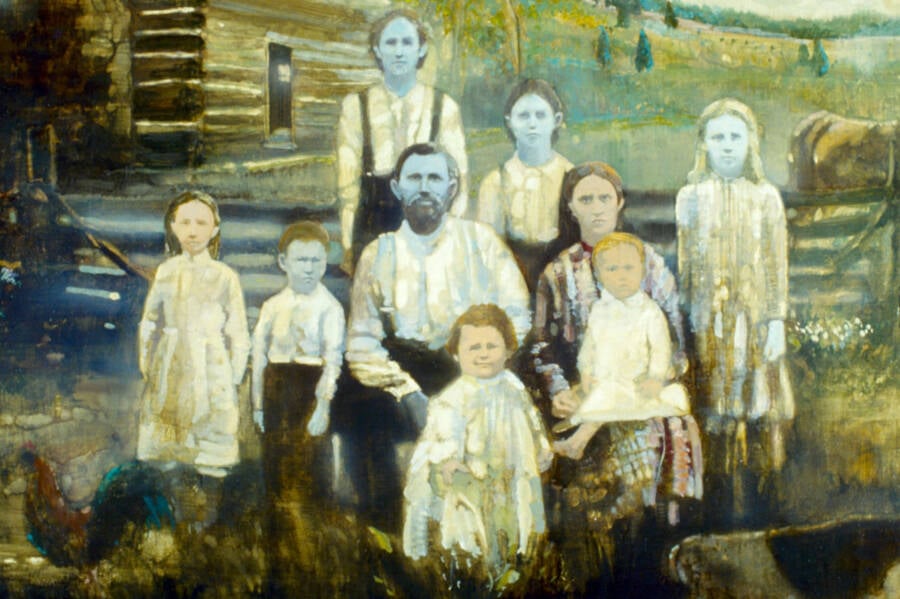For nearly 200 years, the Fugates — known as the blue people of Kentucky — remained largely sealed off from the outside world as they passed their blue skin from generation to generation.
For nearly 200 years, the Fugate family – known as the “Blue Fugates” – passed their blue skin on for generations as they remained isolated from the outside world in the foothills of eastern Kentucky. Even locals who’d lived right nearby for decades would be shocked if and when they stumbled upon one of the infamous blue people of Kentucky.
In fact, when Benjamin “Benjy” Stacy was born in 1975, nurses and doctors were shocked and confused. Rather than coming out a bright shade of crimson like most babies, Benjy was born with dark blue skin. Doctors were so worried by this alien skin color that they called an ambulance to take Benjy the 116 miles from his hometown outside Hazard, Kentucky to the University of Kentucky Medical Center.
After two days of testing, the doctors were no closer to understanding why little Benjy’s skin was blue. Then Benjy’s grandmother spoke up, asking, “Have you ever heard of the blue Fugates of Troublesome Creek?”

Wikimedia CommonsThe descendants of Martin Fugate and Elizabeth Smith, the Fugate family of eastern Kentucky had a blood disorder called methemoglobinemia that turned their skin blue.
At that point, Benjy’s father, Alva Stacy, explained to the doctors, “My grandmother Luna on my dad’s side was a blue Fugate. It was real bad in her.”
Benjy Stacy was the latest child born in a long line of Blue Fugates – the blue people of Kentucky – who had lived in the Appalachian mountains of Kentucky for the past 197 years.
The Origins Of The Blue People Of Kentucky
The first Fugate in the United States was a French orphan named Martin Fugate, who settled in Troublesome Creek in the hills of eastern Kentucky in 1820.

City of HazardA photo of Lorenzo ‘Blue Anze’ Dow Fugate and Eleanor Fugate.
He married a woman named Elizabeth Smith, who was said to be as pale and white as the mountain laurel that blooms every spring around the creek hollows.
Unbeknownst to either of them, by some incalculable odds, both possessed a recessive gene that led to four of the seven children of this union being born with blue skin. In those days in rural eastern Kentucky, there were no roads, and a railroad wouldn’t even reach that part of the state until the early 1910s.

Kentucky Digital LibraryTroublesome Creek, where the Blue Fugates have traditionally resided.
As a result, many of the Fugates began to marry and have children within their own bloodline.
“It was hard to get out, so they intermarried,” says Dennis Stacy, an amateur genealogist, and descendant of the Fugates. “I’m kin to myself.”
Benjy is descended from a line of this family that began when Martin’s son, Zachariah, married his mother’s sister.
This kind of genetic isolation allowed for the continued reproduction and expression of the Fugate family’s “blue skin” gene.
Why The Blue Fugates Stayed Blue For Decades On End

The Fugate Family NewsletterThe Fugate family tree.
Over the next hundred or so years, the Fugates continued to live in relative isolation and were accepted by the people of Troublesome Creek.
“They looked like anybody else, ‘cept they had the blue color,” said one resident.
However, by the early 1960s, some members of the blue Fugates had begun to resent their cobalt-tinted skin. Not only did their skin mark them as different, but by that time, people had already begun to associate their skin color with the family’s history of inbreeding.
It was then that two Fugates approached Madison Cawein, a hematologist at the University of Kentucky’s medical clinic at the time, in search of a cure.
“They were really embarrassed about being blue,” Cawein remembers. “Patrick was all hunched down in the hall. Rachel was leaning against the wall. They wouldn’t come into the waiting room. You could tell how much it bothered them to be blue.”
Using research collected from studies of isolated Alaskan Eskimo populations, Cawein was able to conclude that the Fugates carried a rare hereditary blood disorder that causes excessive levels of methemoglobin in their blood.
Methemoglobin is a nonfunctional blue version of the healthy red hemoglobin protein that carries oxygen. In most Caucasians, the red hemoglobin of the blood in their bodies shows through their skin giving it a pink tint.
For the Fugate family, the excessive amount of blue methemoglobin in their blood turned their skin color blue.
This blood disorder is the result of a recessive gene, and so requires that both parents of a child have the recessive gene for the disorder to appear in their offspring. Without the Fugate’s intense isolation and inbreeding, this disorder would be incredibly rare in their bloodline.
Why The Fugate Family Are No Longer The Blue People Of Kentucky

Wikimedia CommonsHow recessive genes are passed.
Cawein devised a cure for this disorder: more blue. Counterintuitively, the best chemical for activating the body’s process of turning methemoglobin to hemoglobin is methylene blue dye. The Fugates he treated ingested this dye and within a few minutes, the blue coloration of their skin disappeared, and their skin turned pink.
As long as they kept ingesting pills of the substance regularly, these blue people of Kentucky could live their lives normally.
Within a couple of months of his birth, Benjy’s skin color began to change to the average color for a baby. By the age of seven, he had lost nearly all of this blue coloring, indicating that he likely only received a copy of the gene from one parent.
Benjy likely had this gene passed down from his father’s grandmother, Luna.
“Luna was bluish all over. Her lips were as dark as a bruise. She was as blue a woman as I ever saw,” said local nurse Carrie Lee Kilburn.

LinkedInBenjy Stacy, the last of the Blue Fugates, at 37.
Though today Benjy and most of the Fugate family descendants have lost their blue coloring, the tint still comes out in their skin when they are cold or flush with anger. In those moments, the legacy of the blue Fugates of Kentucky lives on — a legacy of hardship, isolation, and perseverance.
Enjoy this article on the blue people of Kentucky? Next, read up on the most interesting diseases to have ever ravaged humanity. Then, have a look at weird mental disorders that you won’t believe are real. Finally, read up on the Turpin family that kept their children locked up.






